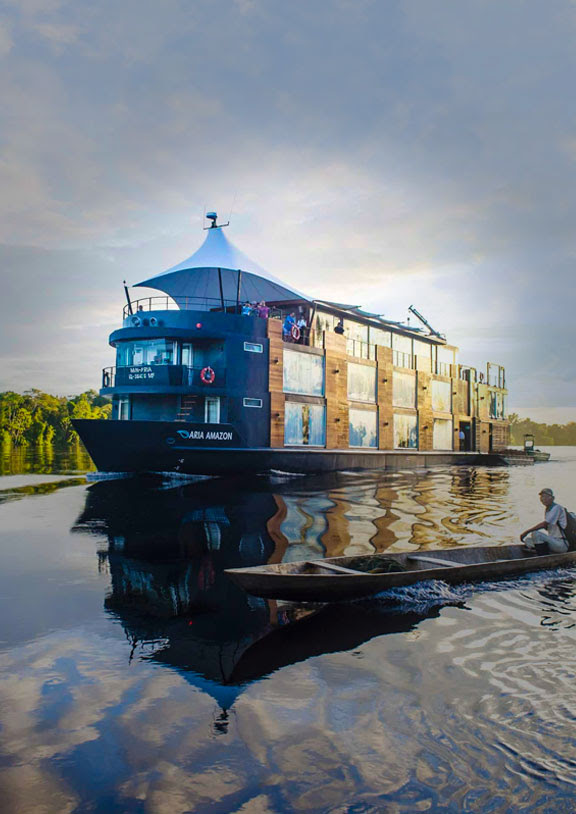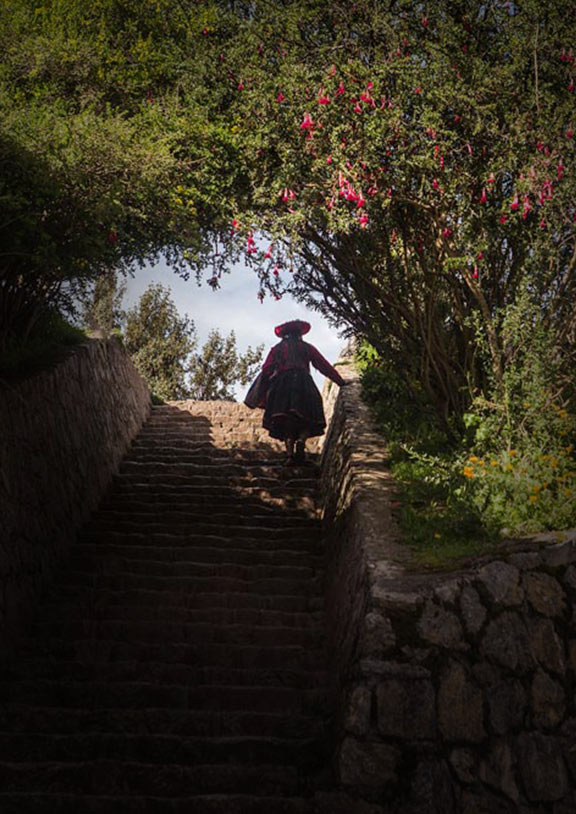There really is no other place on Earth like Peru. The country has everything- literally, everything- that a traveler might want to do. Extreme outdoor sports, remote trekking, gastronomical adventures, snow fun, beach fun, jungle fun, desert fun, cultural experiences, even luxurious splurges- Peru has it all.
The hard part is not finding something you want to do in Peru, but trying to pack it all into one vacation. Speaking from experience, I planned my first trip to Peru for only one week, then realized there was so much more to do and see that I moved permanently 6 weeks later. Even after eleven months in this beautiful country, I still haven’t seen all the highlights.
Alas in hindsight, I have compiled a kind of “cheatsheet” to exploring Peru (which I wish I had before I booked my one-week vacation to the Southern Hemisphere). Without further ado, I present my gift to you, so you know what to do and where to do it in Peru. This will get you ready for that “action-packed, no-surprises” long-awaited dream vacation to one of the most unique countries in the world.
If you like…
You remember when I said Peru has it all? Well, here is a list of the most popular things to do in Peru and the prime locations in which to do them.
What to do and Where to do in Peru
Trekking and Adventure Sports
Nature and Wildlife
Archaeology and Ancient Culture
The Beach Scene
History and Museums
Food and Gastronomical Adventures
Trekking and Adventure Sports
If your dream vacation involves extreme trekking and adrenaline rushes, your itinerary must include a romp through the Peruvian Andes, which are some of the most scenic mountain landscapes in the world. Here are a few top destinations for rough-neck outdoor fun:
Cordillera Blanca and Ancash Province
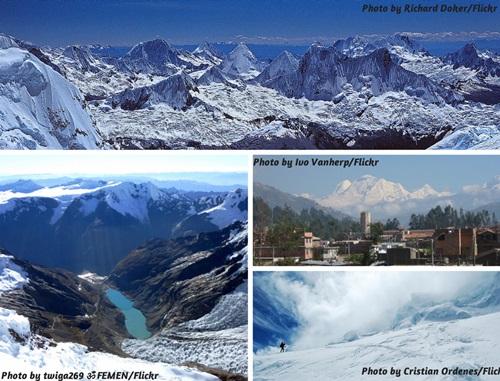 The Ancash region’s Cordillera Blanca is a trekker enthusiast’s hidden paradise.
The Ancash region’s Cordillera Blanca is a trekker enthusiast’s hidden paradise.
Photos combined by Latin America for Less. Original photos taken by Richard Doker, Ivo Vanherp, Cristian Ordenes, and twiga269 ॐ FEMEN/Flickr
This region of Peru is known as the “trekking capital” of the country, and it’s no joke. With a few mountain towns scattered throughout the central Peruvian Andes amidst some of the tallest peaks in the country, the Cordillera Blanca in the Ancash Province is the place travelers go to lose themselves in the beauty of nature and find themselves again enlightened with a new appreciation and respect for Mother Nature. This is where the bold and the fearless go to summit Peru’s highest peak, Nevado Huascaran at 6,768 meters (21,996 feet) above sea level. But if you are looking for something a little less extreme, there are endless hiking options through mountain passes and around crystal blue glacial lakes. The town of Huaraz is a great starting point and/or home base for exploring the Cordillera Blanca and the Ancash Province.
Colca Canyon and Cotahuasi Canyon
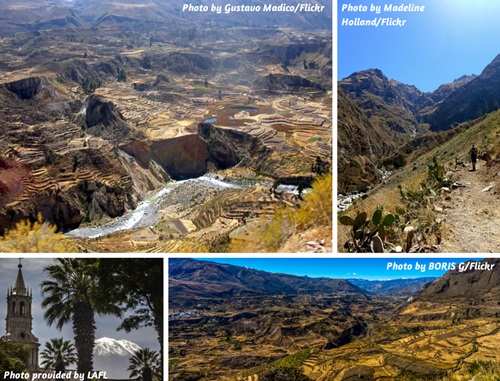 Colca Canyon and Cotahuasi Canyons are two of the deepest canyons in the world. Both are located a few hours outside Arequipa, Peru.
Colca Canyon and Cotahuasi Canyons are two of the deepest canyons in the world. Both are located a few hours outside Arequipa, Peru.
Photos combined by Latin America for Less. Original photos taken by Gustavo Madico, Madeline Holland, and BORIS G/Flickr.
These two canyons are located in the southern Peruvian Andes and are some of the deepest canyons in the world (actually, Cotahuasi Canyon is the deepest canyon in the world). This region has great trekking routes, whitewater rafting, relaxing natural thermal baths, ziplining, horseback riding, and so much more. What I love most about this area is that it it just a few hours outside of Arequipa, one of the coolest and most charming cities in Peru. The best itinerary is where you spend a few days in Arequipa. From there you can head on to explore Colca Canyon first and then the remote and secluded Cotahuasi Canyon. If you are “backpacking it”, I would set aside at least 10 days for this trekking adventure (unless you just want to see Colca Canyon).
Manu Biosphere Reserve
 Manu Biosphere is one of the most secluded jungle reserves in Peru. It will just be you and Mother Nature.
Manu Biosphere is one of the most secluded jungle reserves in Peru. It will just be you and Mother Nature.
Photos combined by Latin America for Less. Original photos taken by Jason Tabarias and Marcel Holyoak/Flickr
Manu Biosphere is one of the most secluded wildlife reserves in Peruvian rainforest, and the people who go visit it are anything but faint of heart. There are a few towns that dot the route to the reserve from Cusco and a couple jungle lodges here and there, but that is about as urban as it gets. When you are in Manu, it is just you and the untamed jungle. Tap into your animal instincts and walk on the wild side… with an expert guide of course.
Nature and Wildlife
Peru has a wealth of protected areas and wildlife reserves. If you are into birdwatching, swimming with sea lions, playing with sloths, hanging out with monkeys, or anything that gets you face to face with the animal and plant kingdoms, then I recommend a trip to the jungle and the national reserve in Paracas.
Peruvian Amazon
 The Peruvian Amazon Rainforest is one of the most biodiverse places on Earth, and home to animal species that do not exist anywhere else in the world.
The Peruvian Amazon Rainforest is one of the most biodiverse places on Earth, and home to animal species that do not exist anywhere else in the world.
Photos combined by Latin America for Less. Original photos taken by Lisa Flippo/Flickr; pruit phatsrivong and Christian Vinces/Shutterstock
Let’s talk numbers for a second. Peru holds the second largest part of the Amazon Rainforest (most of it is in Brazil), and 60% of Peru is tropical rainforest. This portion of the country is home to more than 50,000 different plant species, 1,700 different kinds of birds, 400 mammal types, and 300 different reptile species. And the last statistic to paint the picture, only 5% of Peru’s population lives in the jungle. This means you and your guide are likely to be the only homo sapiens for miles, quite literally. You can expect to see colorful parrots and macaws, dozens of species of monkeys swinging in the tree tops, black caimans, pink river dolphins, and capybaras swimming in the Oxbow lakes, giant lily pads, and maybe even some jungle predators like the black panther, spotted ocelot, or a leopard lounging in the thick, green vegetation.
A trip to the jungle is an opportunity to see what untouched nature really looks like. If you are in the northern jungle around Iquitos, stay at a jungle lodge near Pacaya-Samiria National Reserve about 2 hours southwest of the city for the best opportunities to see undisturbed wildlife. For those traveling in the southern jungle, check out the Tambopata National Reserve just outside of Puerto Maldonado, or Manu Biosphere east of Cusco.
Paracas National Reserve
 Paracas National Reserve is one of the few protected coastal areas in Peru.
Paracas National Reserve is one of the few protected coastal areas in Peru.
Photos combined by Latin America for Less. Original photos taken by CHIMI FOTOS, Geraint Rowland, and Martin Garcia/Flickr; and San Gallan Xpeditions
Paracas is a little known haven for wildlife located on the Pacific coast about 5 hours south of Lima by car (buses stop there frequently as well). It is a great place to see sea lions, sea birds, dolphins, and other wildlife. The air is crisp, and the water is crystal clear. Boat tours run daily when the sea is calm and you will get an opportunity to tour the channels between the Islas Ballestas off the coast.
Here is an even lesser known fact: the Island of San Gallan just off the coast of Paracas is not only a wildlife reserve, but also home of some perfect waves when a south swell fills in. When I go to Paracas, I always bring my warm wetsuit and a board to enjoy the surf with the resident sea lions. If you like a little luxury mixed with your wildlife adventure, I recommend staying at the five-star Hotel Libertador or the Aranwa Paracas Resort and Spa. These accommodations are the cherry on top to a Paracas getaway.
Archaeology and Ancient Culture
Most people visit Peru to see the ruins of ancient civilizations and learn about their culture, but there is more to see and experience than just Inca ruins and Machu Picchu. If ancient ruins and folklore tickle your fancy, I suggest you add a couple of these places to your itinerary when you visit Peru.
Trujillo and Chiclayo
 Trujillo and Chiclayo are home to the ruins of the ancient Moche civilization with archaeological sites having been discovered as late as the 1980s.
Trujillo and Chiclayo are home to the ruins of the ancient Moche civilization with archaeological sites having been discovered as late as the 1980s.
Photos combined by Latin America for Less. Original photos taken by Andy Hares, Nicole Courneya, and Tyler Bell/Flickr
These two cities are located about 2.5 hours away from each other along the Pacific coast in a region that has received the reputation as “land of eternal spring.” But other than the comfortably warm sunny weather nearly all year round, travelers visit these cities to explore the ruins of the Moche civilization that inhabited the northern coastal region of modern-day Peru before the rise of the Inca Empire. Near Trujillo are the ruins of Chan Chan, which is the largest ancient city discovered in the Americas. Archaeologists say that the city of Chan Chan was more or less the capital of the Chimú Nation, which predates the Inca by about 900 years. Just north of Trujillo in Chiclayo is the archaeological discovery of the tombs of Señor de Sipán, or Lord Sipán. The tombs (a total of 14) were so lavishly decorated and filled with precious treasures and remarkably untouched by looters upon its discovery in the late 1980s. The tombs date back to as early as 300 C.E., about 1100 years before the height of the Inca Empire.
Caral-Supe
In the mid 20th century, archaeologists uncovered the most ancient city in the Americas. The civilization that occupied the city is thought to have lived there between 4000 and 4500 years old. Caral-Supe takes up about 35 square miles of coastal terrain lying about 3 hours north of Lima, making it a nice day trip.
Chachapoyas
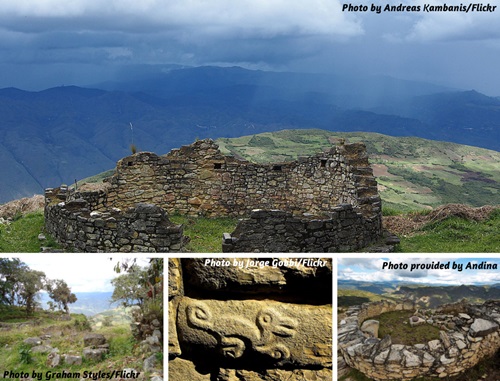 Kuelap Fortress outside of Chachapoyas is one of Peru’s best kept archaeological secrets.
Kuelap Fortress outside of Chachapoyas is one of Peru’s best kept archaeological secrets.
Photos combined by Latin America for Less. Original photos taken by Graham Styles, Jorge Gobbi, and Andreas Kambanis/Flickr; and Andina
On the eastern side of the Andes Mountains in the northern highlands of Peru is the small town of Chachapoyas. The town itself doesn’t have much to offer, but it is the home base for visits to the remote Kuelap Fortress ruins. The remains of this ancient city were constructed around the 6th century C.E. on the sharp ridges of the mountains overlooking the cloud forests of the highland Amazon Rainforest. If you go today to visit Kuelap, the trip is grueling, but the Peruvian government is talking about building an airport in Chachapoyas to make it more accessible to visitors.
Puno and Lake Titicaca
 Lake Titicaca is a mystical place with a history that is kept alive in the traditions of the people who live there.
Lake Titicaca is a mystical place with a history that is kept alive in the traditions of the people who live there.
Photos combined by Latin America for Less. Original photos taken by Marie Therese Herbert & Incacity/Flickr; vitmark/Shutterstock; and Latin America for Less
Puno is considered the folkloric capital of Peru due to its rich traditions and festivals, and Lake Titicaca is the mythical birthplace of the founders of the Inca civilization. This region is truly shrouded in mystery, and you will know what I mean when you visit some of the main attractions, like the floating islands of Uros, the ancient tombs of Sillustani, the unique indigenous communities of Taquile and Amantani Islands, among so much more. It is like the people never needed to write down their history because they keep it alive with their age old traditions.
Cusco and the Sacred Valley
 Cusco and the Sacred Valley are at the center of the ancient Inca Heartland, and the ruins still standing are of the few pieces of history left behind of this once great civilization.
Cusco and the Sacred Valley are at the center of the ancient Inca Heartland, and the ruins still standing are of the few pieces of history left behind of this once great civilization.
Photos combined by Latin America for Less. Original photos taken by Edyta Pawlowski, Neale Cousland, and 3523studio/Shutterstock; and Dreamstime
Some people might be so obsessed with Machu Picchu that they hop on a plane to Cusco and head straight for the citadel. This is a big mistake for two reasons. First, Machu Picchu rests at an altitude of 2,430 meters (7,972 feet) above sea level, which is a little higher than the elevation at Aspen, Colorado, in the Rocky Mountains. If you hike Machu Picchu on the first day being in the Andes, chances are you are going to suffer from some altitude sickness, making for an unpleasant Day 1 of your itinerary. Reason Number 2 is Cusco city and the nearby Sacred Valley are the center of the Inca heartland. There are so many ruins left by the Inca that are still intact just scattered along the mountain sides. Sacsayhauman, Qenqo, Pucapucara, and Tambomachay are all within 30 minutes of Cusco’s main square and are perfect “starter attractions” for your first day in Cusco. Take a day trip through the Sacred Valley and see more examples of Inca craftsmanship in Pisac and Ollantaytambo. Make sure to also spend some time enjoying Cusco’s amazing local cuisine while you’re acclimatizing. By the third day, you are prepared mentally and physically for a hike to Machu Picchu.
The Beach Scene
Tumbes, Mancora, and Punta Sal
 The northern coast of Peru is a beach-lover’s paradise.
The northern coast of Peru is a beach-lover’s paradise.
Photos combined by Latin America for Less. Original photos taken by Luis Lago and Renzo Vallejo/Flickr; Yhan Sandoval/Facebook
The northern coast of Peru is the place for sun, surf, and beach fun all year round, but the most fun happens during the summertime (December through March) when all the Limeños (people from Lima) escape the hustle and bustle of the city. Tumbes, Mancora, and Punta Sal are the most popular destinations, all three about 3 hours from each other by car and practically on the border with Ecuador. The sun is warm, the water is refreshing, and there is always a party. These cities are also known for their resort hotels and spas, wild full moon parties, and epic conditions for kitesurfing (mainly during the months of May through August).
Huanchaco and Playa Chicama
 Hunachaco and Playa Chicama are in the land of “eternal springtime”, and it is home to some of the best waves in Peru.
Hunachaco and Playa Chicama are in the land of “eternal springtime”, and it is home to some of the best waves in Peru.
Photos combined by Latin America for Less. Original photos taken by Jonathan/Flickr; Christian Vinces/Shutterstock; Juancarlos Gonzalez/Facebook
About 11 hours by car (a little over 1 hour by plane), Huanchaco and Playa Chicama are in the part of Peru that experiences “eternal springtime”. Ninety percent of the time it is warm and sunny – call it the “Southern California of Peru,” minus the celebrities, paparazzi and million dollar homes. This area is a personal favorite because it is the home of the iconic totora reed fishing rafts (the first prehistoric surfboards), and the longest left breaking wave in the world (more than a mile long from point to pier). In this area, there are at least 50 hidden surf spots along a 70 kilometer (43 mile) coastline offering perfect waves. Not to mention that these towns are fishing ports. Get ready for some the freshest seafood of your life. Head down to the pier around 6 or 7 am for the first catch of the day. This area is undoubtedly one of Peru’s best kept secrets.
South of Lima
Here is the sad truth: Lima does not have the nice sandy beaches you dream of when planning your summer fun beach getaway. But about 40 kilometers to the south of the city are lovely beaches with white sand, warm sunshine (in the Peruvian summertime), and cleaner water. During the summer months, Limeños will rent beach houses in Punta Hermosa, San Bartolo, and Asia to escape the city and relax on the sand or in the water. Probably one of the best parts about the beaches south of Lima is the personal delivery of cold beers and fresh ceviche right to your beach chair on the sand. The shore is lined with dozens of restaurants that take personalized service to a whole new level.
History and Museums
Lima
 As Peru’s capital city, Lima is the cultural hub of the country, with numerous museums displaying the most interesting and unique artifacts, fine art, and historic and pre-historic pieces of Peru.
As Peru’s capital city, Lima is the cultural hub of the country, with numerous museums displaying the most interesting and unique artifacts, fine art, and historic and pre-historic pieces of Peru.
Photos combined by Latin America for Less. Original photos taken by hhesterr/Flickr; Christian Vinces/Shutterstock
Lima is the oldest colonial city in South America, so naturally it is going to have a plethora of museums and historical buildings. Most of the historical buildings are located in the downtown area known as the historical center of Lima, while most of the museums are in the district of Pueblo Libre. Spend two days checking out the sights around the city. For the first day, you can explore the Plaza de Armas and Plaza de San Martin, where the you will find the colonial structures like the Presidential Palace, Basilica Cathedral, the catacombs of the Church of San Francisco, and even the oldest colonial mansion in South America, Casa de Aliaga. Then on the second day, visit the Larco Museum for a dose of interesting (to say the least) pre-Columbian Peruvian archaeological artifacts dating back to more that 3000 years ago, and then stop over at the Museo Oro del Peru to see a large collection of ancient pre-Inca gold-crafted artifacts. Next door is the “Weapons of the World” exhibit displaying everything from swords, daggers, uniforms, guns, pistols, and spears. And for you art lovers, the district of Barranco has the trendy Museum of Contemporary Art and the MATE featuring works of the Peruvian artist Mario Testino. In all honesty, you could spend at least 3 or 4 days exploring the museums in Lima. There is literally something for every particular interest, from art, culture, food, archaeology, or history.
Arequipa
 Arequipa is a charming city that is unlike any other in Peru.
Arequipa is a charming city that is unlike any other in Peru.
Photos provided and combined by Latin America for Less.
Arequipa is one of my favorite cities because it has its own unique flavor and spunk – quite literally. It has dozens of boutique hotels housed in restored colonial mansions from the 17th and 18th centuries, many of which have spectacular views of the surrounding mountains and volcano, El Misti. The city does not only have a rich history, but also has its own category of cuisine, which can be defined as wholesome, hearty, and, oh yes, a little on the spicy side. In between exploring the lovely colonial buildings made of sillar and the Archaeological Museum (home of the Juanita, the “ice maiden mummy”), take time to enjoy a delicious Arequipeño plate called rocoto relleno (baked spicy rocoto peppers stuffed with beef).
Food and Gastronomical Adventures
 Peru is a gastronomical mecca for foodies.
Peru is a gastronomical mecca for foodies.
Photos combined by Latin America for Less. Original photos by Esteban Llugany, _e-t., and thatsprettycool/Flickr; and Latin America for Less.
Honestly, the entire country is one big gastronomical adventure, but Lima is definitely the hub for all things culinary, both nationally and internationally. The city has some of the best restaurants and chefs in the world. Just recently, Virgilio Martinez’s restaurant Central was awarded Best Restaurant in Latin America by San Pellegrino & Acqua Panna. But Lima also showcases all the regional Peru favorites, like cuy (guinea pig), the freshest ceviche (raw seafood served with limón and red onions), traditional plates from the Andean highlands and the jungle, and some of the best pastries that have ever touched your tastebuds. Some of my personal favorite dishes are tacu tacu (a rice and bean dish traditionally served with beef and veggies or shrimp), aji de gallina (shredded chicken breast in a thick sauce made with aji served over potatoes and rice), and lomo saltado (thick cuts of beef in a veggie stir-fry served over rice and fried potato wedges). For dessert, try anything made with manjar blanco (a sweet caramel frosting spread or filling), or delicious picarrones (a kind of doughnut made from sweet potato flour drizzled with honey or syrup).
Now do you believe me when I say Peru has it all? Contact us to learn more about how to maximize your time in Peru!

Katy is no stranger to the life of an international traveler. After graduate school, Kathleen worked in California in the legal field, but later realized that life was calling her in a different direction. After a short time in Peru, she fell in love with the culture, the people, the food, and the way of life. Now Kathleen calls Lima her “home away from home,” although she frequently visits the warm, sunny northern Peru to see friends and surf.



